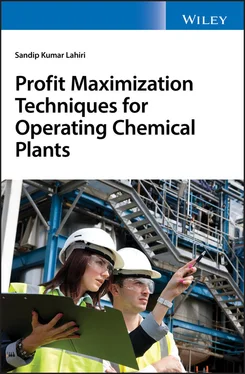Assessment of Current Plant Status
An assessment of current plant status and know where you are is the first major step in building a profit maximization project. This chapter deals with the holistic approach to assess the current plant status. How to assess the performance of the base regulatory control layer and the advance process control layer of running a plant is discussed in detail in this chapter. A performance assessment of the major process equipment and an evaluation of the economic performance of the plant against a benchmark are two key focus areas discussed in this chapter. An assessment of profit suckers and identification of equipment for modeling and optimization and an assessment of process parameters having a high impact on profit are two takeaways in this chapter. Readers are enlightened with an assessment of various profit improvement opportunities.
Process Modeling by an Artificial Neural Network
Chapter 7emphases the need for data‐driven black box and grey box modeling techniques where building of a first principle‐based model is infeasible or time consuming due to the complexity of the industrial equipment. How an artificial neural network (ANN) can be utilized as an effective tool of black box modeling in an industrial context is discussed in this chapter with various real‐life applications. A step‐by‐step procedure to build an ANN‐based modeling platform to utilize a large amount of process data is explained in detail with example calculations. The new horizon of modeling process performance parameters like selectivity, yield, and efficiency and how these models can be utilized to increase profit is explained here. Different examples and case studies of ANN models already applied in diverse fields of process industries are illustrated to give the reader a feel for large scope and potential of applications of the ANN in industry.
Optimization of Industrial Processes and Process Equipment
Due to cut‐throat competition in business, companies now want to reduce their operating costs by optimizing all of their available resources, be it man, machine, money, or methodology. Optimization is an important tool, which can be utilized to strike a proper balance so that profit can be maximized in the long run. Since capital cost is already incurred for a running plant, optimization essentially boils down to minimization of the operating cost for the operating plants. In running a chemical plant, there is a huge scope to optimize the operating parameters, like temperature, pressure, concentration, reflux ratio, etc., which gives either a higher profit through higher production or lower operating costs. There are many ways to optimize the operating conditions of reactors, distillation columns, absorbers, etc., to enhance their profitability. Chapter 8lays the foundation about how parameter optimization can be utilized to increase profit in running the chemical plant. Conventional optimization techniques are initially discussed to enlighten the reader about the scope and huge potential of optimization in the process industry. This chapter introduces new advanced Meta heuristic optimization techniques that can be applied where application of a conventional technique is limited due to the complexity of the industrial context. Different Meta heuristic optimization techniques, like the genetic algorithm (GA), differential evolution (DE), simulated annealing (SA), etc., are described in detail in this chapter. A basic algorithm, step‐by‐step procedure to develop an optimization technique and different uses of GA, DE, and SA in various fields of process optimization are explained here in order to develop an understanding of this new area. A case study in reactor optimization is illustrated to explain the advantage and ease of implementation of Meta heuristic methods over conventional methods.
Today's complex chemical plants need advanced monitoring and control systems to quickly identify the suboptimal operation of process equipment and implement a quick optimization strategy. Running the plant at the highest possible capacity for profit maximization necessitates the development of an intelligent real‐time monitoring system. However, due to the large amount of process data, it is a herculean task to monitor each and every piece of process data. Chapter 9enlightens the readers about an online intelligent monitoring system, KPI‐based process monitoring, a cause and effect‐based monitoring system, etc. It also gives an idea regarding the development of a potential opportunity‐based dashboard, loss and waste monitoring systems, a cost‐based monitoring system, a constraints‐based monitoring system, and how all these can be integrated into business intelligent dashboards.
In this chapter, a new advanced computational technique, namely principal component analysis (PCA), is discussed to visualize data. The advantage of such an online monitoring system is to visualize the plant condition from a higher level but with a lower dimension space. A step by step procedure to build a PCA‐based advance monitoring system is explained in detail, with examples and industrial case studies.
Chemical industries recently discovered that a large amount of profit becomes eroded due to unplanned shutdowns of the plant. Due to spurious trips of equipment much potential profit is lost. One major ingredients of profit maximization is to increase plant reliability and running hours. Plant shutdown can be avoided by building a robust fault diagnosis system that will detect and alert the operator about any potential event that can lead to plant disturbance and eventually plant shutdown before it starts happening. How a robust fault diagnosis system can be made by PCA and ANN that can be implemented in industry is discussed in detail in this chapter with industrial case studies. Different aspects of enhancement of plant reliability by an advance monitoring and fault diagnosis system is the main focus of the chapter.
Optimization of the Existing Distillation Column
Often distillation columns cause a bottleneck to increase plant capacity. It is very important to understand the operation and capacity limits of distillation columns in commercial plants. Chapter 11enlightens the reader about how to evaluate a feasible operating window by using a capacity diagram. Calculations based on the capacity diagram and the effect of different design and operating variables on the capacity diagram are explained in detail with example calculations. This chapter enlightens the reader about operating profile assessment, tower rating assessment, tower efficiency assessment, and hydraulic performance evaluations of running distillation columns. It also provides practical guidelines regarding what to look for in distillation column optimization in an industrial context and explains the whole concept with real‐life case studies.
Due to intense competition among chemical industries across the globe, it is now absolutely necessary to minimize the cost of equipment during the design phase. Equipment costs consist of the initial capital cost of the equipment and the operating costs of the equipment. Due to the availability of a faster computer, it is now feasible to design one million different design configurations for any equipment. It is important to choose the lowest cost equipment among those one million options, but one that also obeys all of the constraints of operation, safety, maintainability, etc. Hence, to survive in today's cut‐throat competition, it is necessary to put the minimization of equipment cost as the main design target and an optimization algorithm is required to search all feasible design configurations to arrive at a minimum cost design quickly. This gives rise to a new design methodology of process equipment. Earlier traditional design methodology, where cost is not considered as a design target during the design phase, no longer produces a competitive design. In this chapter, a new design methodology of a plate‐type distillation column is considered as a case study to show the essence of the new design methodology. This chapter evolves a strategy to optimize various tray geometric parameters, like tray diameter, hole diameter, fractional whole area, downcomer width, etc., and also decides on the optimum feed tray location based on the overall cost minimization concept by particle swarm optimization techniques.
Читать дальше












